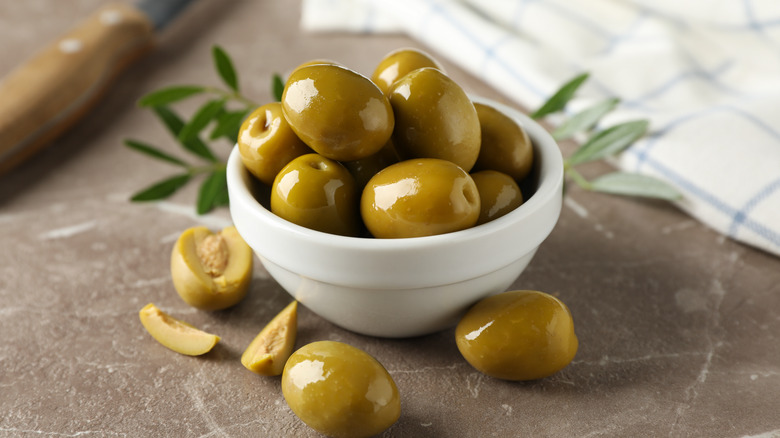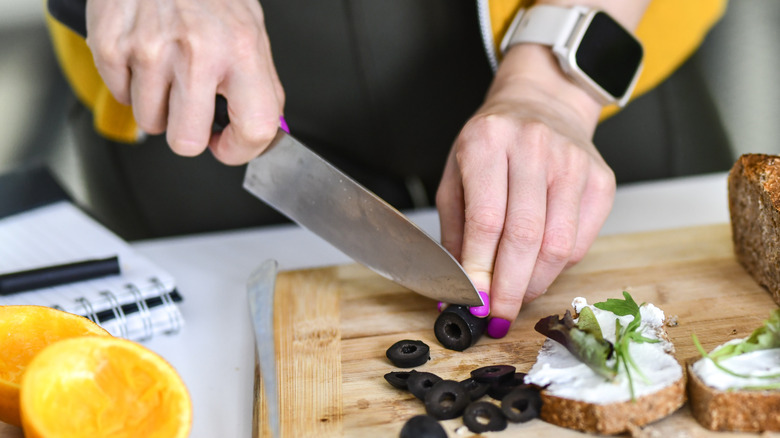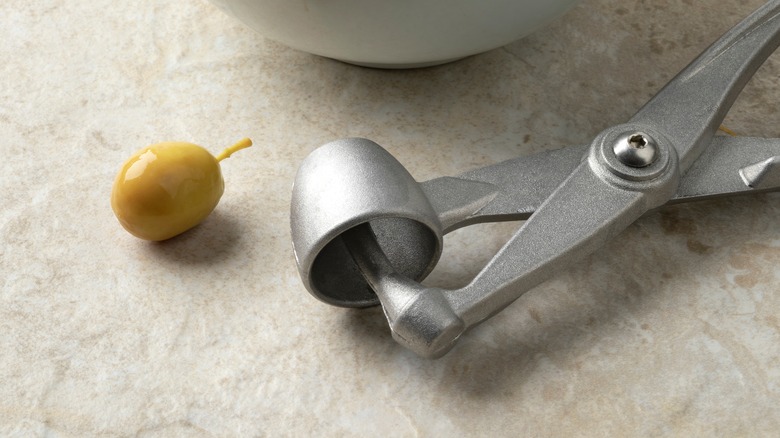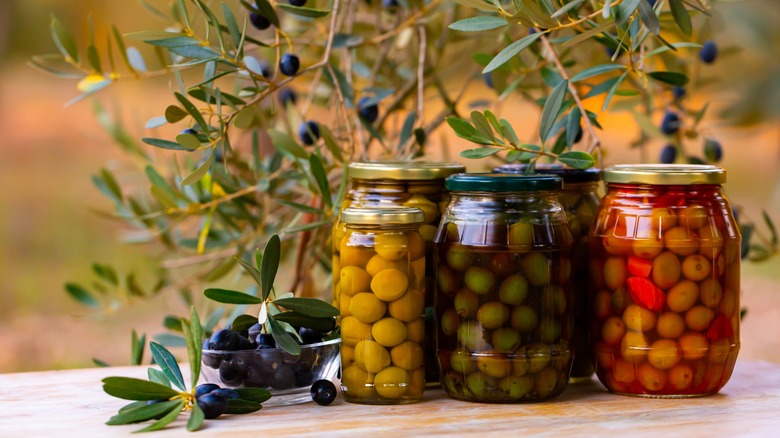How To Pit Olives
First things first: You're forgiven if you assumed that "pitted" olives have pits and "unpitted" ones don't. It's easy to get the terms mixed up; if you have trouble keeping them straight, you're not alone. Type "unpitted olives" into your search bar, and Google will suggest queries like "unpitted olives meaning" and "what are olives without pits called?"
Let's clear up the confusion. "Pitted" refers to the pitting process, so "pitted olives" are olives that have had the pits removed. Olives with pits are called "unpitted olives."
While pitted olives are a common sight on grocery store shelves, serious olive fans eschew them, claiming that unpitted olives taste better and have a nicer texture. Not everyone likes them, though. Former U.S. representative and two-time presidential candidate Dennis Kucinich, for example, sued a cafeteria operator for $150,000 after he cracked his tooth on an unpitted olive. So, if you want the best of both worlds — flavorful olives and fully intact teeth — learn to pit olives yourself. Don't worry, you won't need any special gadgets. All you need are some readily-available kitchen tools and a bit of time and effort.
How to pit olives using a knife
When it comes to pitting olives, experts agree that it's best to keep things simple. While the method you'll use depends on the type of olive that you're working with, two main techniques will cover the bulk of your pitting needs.
Dark olives have had time to ripen, so their flesh falls away from the pit with minimal effort. To pit them, place them on a flat surface like a cutting board or baking sheet, then crush them with the side of a large chef's knife. The flesh should break away from the pit. Use your fingers to peel away any leftover flesh, then discard the pit. Green olives, which are picked before they're fully ripe, can be a bit trickier. If you're having trouble, use a paring knife to carefully cut around the olive's circumference and gently pull it apart.
Admittedly, an olive that's been smashed into a pulp isn't going to be all that pretty. That's why olives are often served unpitted in Greek salads or on charcuterie boards. If you find yourself facing an unpitted olive at a social event, etiquette dictates that you should chew away the flesh, then discreetly spit the pit out behind your hand or a napkin. Dispose of the pit by placing it on your plate or in a designated bowl, or by wrapping it in a paper napkin.
Do olive pitters work?
The short answer: No, not really.
The long answer is a little more nuanced. If you already have a cherry pitter, it might be worth seeing if it can pull double-duty — sometimes, pitters are even marketed for both cherries and olives. However, while cherries are relatively uniform in shape and size, olives are much more diverse. Olives can be big and round or small and slim, firm to the touch or soft and pliable. No tool will be one-size-fits-all. In addition, while cherry pits generally break away from the flesh cleanly, olives cling to their pits.
If you find that pitters work for you, go ahead and pit away, but don't run out to buy one under the assumption that it will make the process easier. Chances are, it won't. Save yourself the money and space, and use a knife instead. Just make sure it's a sharp one — a properly maintained blade will make the pitting process much smoother.
Why should you buy unpitted olives?
Pitted olives tend to fall short of unpitted ones in terms of both taste and texture. When olives are sold whole, the skin protects the soft flesh from the brine. However, because pitted olives don't have a fully intact skin, brine soaks in, overwhelming the fruit's subtle flavors.
Exposure to brine changes the olive's texture, too. In general, texture plays a big role in how we perceive the foods that we eat; it's often a deciding factor in whether or not we enjoy our meals. When pitted olives soak in brine for months, once-crisp olives turn mushy and soft.
There are exceptions. Naturally, pimento and other stuffed olives come pitted. If you're making a tapenade, you might want to use pitted olives, too. Their soft texture is perfect for a smooth spread. You'll also save yourself lots of time, something to keep in mind when using any recipe that calls for a large quantity of olives. Finally, subtle nuances in an olive's taste and texture won't come through in flavorful sauces or stews. Learn to bend the rules when necessary, and you'll save yourself a lot of time and effort.



